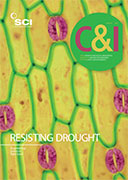The complexity of life
Reviewer
Michael Gross
Title: What is life?
Author: Addy Pross
Publisher: OUP, Year: 2016, Pages: 224, Price: £9.99, ISBN: 978-0-19-878479-1
Consider river beds – isn’t it amazing that they all provide channels for water to flow downhill and into the oceans, from where it can evaporate, form clouds and precipitations and start the hydrological cycle afresh? Some might argue that rivers keep flowing as if they had a ‘sense of purpose’, to transport water around the continents and towards the oceans.
And the next time you pull the plug on your bathtub, consider the whirl that is going to form over the plughole, enabling the water to drain faster. If you turn a full bottle upside down, it will drain very slowly and with hiccups because air gets into the bottle as the water wants out. But if you give it a quick circular swing to initiate a similar whirl, the water will spiral down the rim very efficiently, with the air entering through the hole in the centre of the whirl. Does that mean the water in the bathtub has a sense of purpose too, enabling it to speed up draining by spontaneously forming an ordered structure, and seemingly violating the second law of thermodynamics? In a word: no.
Nature has many ways of creating order from disorder, using energy gradients to drive processes against the flow towards increased disorder in the Universe, as dictated by the second law. Many of the ordered structures, from galaxies to crystals, could be interpreted as having been designed for a purpose, but they probably weren’t.
Life is the most complex and perhaps most surprising of these natural phenomena of spontaneous self-organisation. From the ancient philosophers through to the Renaissance, people used to think that life has a special essence not present in non-living things, the vis vitalis or life force. It was perhaps the most significant breakthrough in the history of science when the scientific revolution ditched this idea and realised that life is just a state of matter that can reproduce and evolve gradually over many cycles of reproduction.
In 1943, when Erwin Schrödinger conceptualised the question: ‘What is life?’ he asked two fundamental questions: how does life produce order from disorder; and how does it reproduce its own ordered state – order from order? At the time, science had no answers for either question, but with his elegant physical framing of fundamental biological questions, Schrödinger helped the subsequent birth of molecular biology. Since then, progress in biology has been so rapid that both questions can be answered today without recurring to a special vital force, not even in its modern reincarnation, known as teleonomy or ‘sense of purpose’.
Life’s ability to proliferate exponentially for as long as the raw materials are available and to evolve over consecutive reproduction cycles by virtue of the balance between mutation and selection explains its success and apparent sense of purpose. Living things do whatever serves their reproduction because the earlier precursors that didn’t would have failed to reproduce. And this explanation holds from chemical replication systems, some of which have already been modelled, through the RNA world and first cells, to plants and people.
In his book, borrowing Schrödinger’s famous title some seven decades later, Pross builds up life’s ‘sense of purpose’ as a formidable challenge that biology has failed to explain. To me, teleonomy is an obvious consequence of Darwinian evolution. In our efforts to work out how it works in detail, systems biology and the various ‘-omics’ have made a good start since the millennium by attempting to put back together the pieces that reductionism has successfully dissected and characterised and to see how they work as a network of interactions. Pross dismisses systems biology, along with the contributions of complexity theory.
As the author spends six of eight chapters lamenting the failure of biology to capture the essence of life and explain its origins, suspense builds as to what the solution to the alleged crisis might be. In chapter seven, he reveals the miracle cure: systems chemistry. By this he means that chemical, self-replicating systems must have preceded the cellular ones. While I am always in favour of more chemistry and more interdisciplinary approaches involving chemistry, I believe that such research has been done for decades and already made valuable contributions to the ‘origin of life’ debate. Thus I think that both the looming crisis in biology and its promised solution have been exaggerated by Pross.
In the end, Pross argues - and I agree with his assessment - there should only be one evolution, leading from simple molecular systems to today’s diversity and complexity of life.
Michael Gross is a science writer based in Oxford, UK
The best way to keep up to date with all of the latest, cutting edge technologies from the lab to the market!
Author
Publisher
Pages
Price
ISBN





